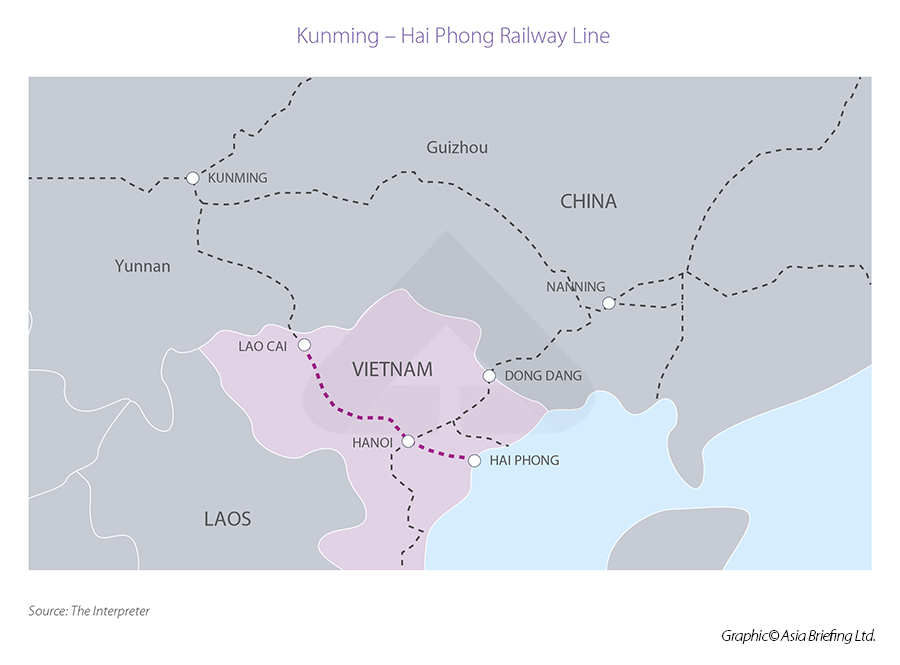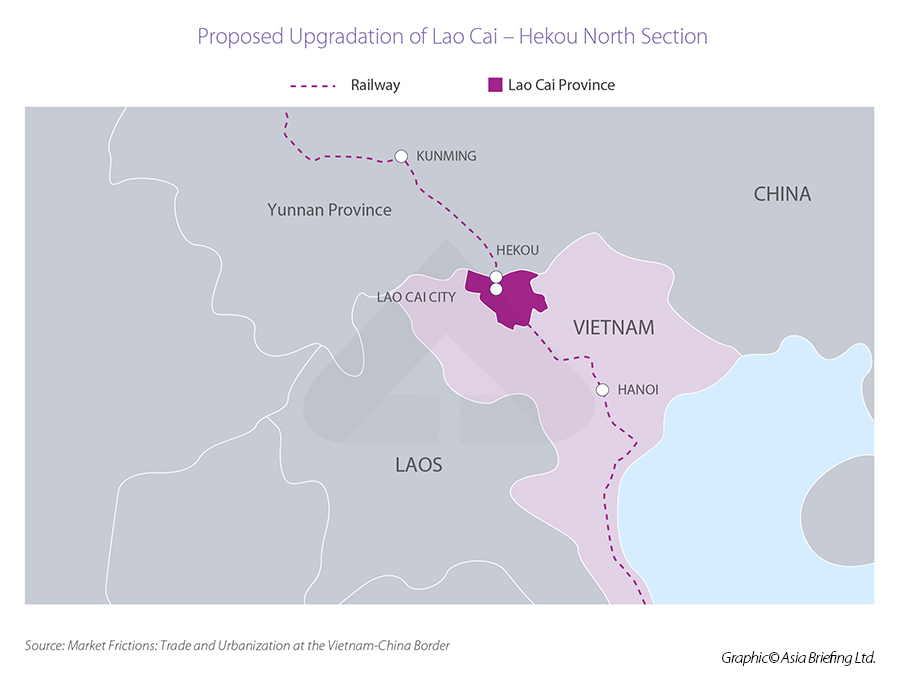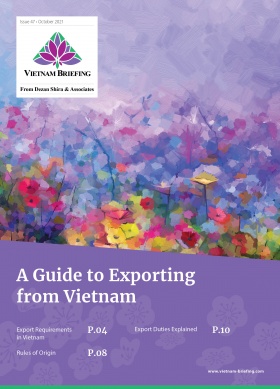Vietnam-China Trade: Transport Ministry Proposes Update to Railway Link
- Vietnam has proposed renovations and upgrades to the cross-border line between Vietnam’s Lao Cai Station and China’s Hekou North Station on the Kunming-Hai Phong railway line facilitating two-way trade between both countries.
- The upgrades include the renovation of track gauges to match China’s track gauge system, the construction of a railway tunnel, and a high-capacity warehouse.
- The Kunming-Haiphong railway fosters China-Vietnam trade with its strategic location in the Kunming-Lao Cai-Hanoi-Haiphong economic corridor.
The Vietnam Railway Project Management Board under the Ministry of Transport has proposed a US$95.95 million (VND 2.2 trillion) project that would upgrade railway links between Vietnam’s Lao Cai Station and China’s Hekou North Station on the Kunming-Haiphong route between Vietnam and China. The project is expected to use US$ 97.5 million (VND 2.2 trillion) from the national 2021-2025 budget and be completed before 2025.
Vietnam’s railway system plan for 2021 to 2030 with a vision to 2050 will see Vietnam build nine new railway lines by 2030. In addition, by 2030, the volume of goods transported by cargo railway will account for 0.27 of market share, while passengers transported through railways will account for 4.4 percent as per the plan.
The Kunming-Haiphong railway helps facilitate trade in the Kunming-Lao Cai-Hanoi-Haiphong economic corridor, an important trade route and gateway of Vietnam to ASEAN countries and China.
History of the Kunming-Haiphong railway
In 2019, the Ministry of Transport proposed the construction of a 392 km (244 miles) railway line, spanning across 38 stations, running from Lao Cai to Hai Phong via Hanoi. It also includes a 5.6km (3.5 miles) cross-border line connecting Lao Cai with China’s Hekou Railway Station.
The rail lines are an extension to the 855 km (530 miles) long rail line from Hanoi through Lao Cai to Kunming, the capital of China’s Yunnan province, built by the French in the 1900s. The section within China from Kunming to Hekou is known as the Kunming–Hekou railway while the section within Vietnam is known as the Hanoi–Lao Cai railway line. The route, now known as Kunming-Haiphong, plays a significant role in transporting goods between the northern localities of Vietnam and China.
The Kunming-Haiphong railway includes two sections. The section within Vietnam runs east through eight provinces and cities, starting at Lao Cai, then towards Yen Bai, Phu Tho, Vinh Phuc, Hanoi, Hung Yen, and Hai Duong, and ending in Lach Huyen port in Hai Phong. Across the border from Lao Cai Station, the section within China starts at China’s Hekou North Station and ends with a final stop at Kunming.
The decision to bridge a standard rail connection to Hai Phong, the most important port in Northern Vietnam, presents a geopolitical and economic interest. To Vietnam, it means improved convenience, larger capacity for import and export of goods, and passenger transportation, aiding the development of Vietnam’s northwest provinces.
However, its benefits to China-Vietnam trade were unclear. While trade with China through land transport may not need a harbor, Hai Phong does not present a clear shortcut to connect with sea transport for China, with various harbors along its coastline. On the other hand, it suggests further opportunities to maximize the railroad’s value.
The newest proposal presents an opportunity. Vietnam has a narrow-gauge railroad while China has a broad gauge one with only narrow gauge in specific sections of some border provinces. This means that Vietnamese trains from Lao Cai Station can only travel to certain stations in China with the furthest being China’s Hekou North Station. Goods have to be transferred and reloaded onto another train to enter China’s railway system. The same thing happens when Chinese trains enter Vietnam.
Therefore, renovation to the connecting point between two railway sections in Vietnam and China is expected to foster China-Vietnam trade.
Cross-border upgrades intended to boost commercial relations
The proposed rail project would start at the Lao Cai Station and end at the Ho Kieu Bridge in the province that stands on the border between both countries.
It would include renovating 3 km (1.8 miles) of rail tracks at the Lao Cai Station to have double tracks with standard and meter gauges, one of which of the same size as that of China, and an additional 2.85 km (1.8 miles) of twin rail tracks of both gauges will be built from the northern parts of Lao Cai to the Ho Kieu Bridge. A railway tunnel spanning 1,700 meters and a warehouse with a capacity of five million tonnes a year will also be built, among other infrastructural upgrades.
Vietnam-China trade and how proposed railway upgrade will aid growth
The proposed updates are expected to cut down costs and facilitate transportation between the two countries, speeding up the flow of trade.
In 2020, Vietnam’s railway transport of goods from Vietnam to China and other countries reached nearly 900,000 tonnes, up about 10 percent year-on-year, in which more than 90 percent of border trade with China flowed through the Lao Cai-Hekou railway line.
Regarding the construction of the China-Vietnam international railway and border roads, China sees Vietnam as one of the countries with the highest level of infrastructure connectivity.
The railway is part of the Two Corridors, One Belt (TCOB) initiative between Vietnam and China, connecting southern China and northern Vietnam, under China’s Belt and Road Initiative (BRI), a Chinese global strategy to foster connectivity between Asia, Africa, and Europe through land and maritime networks facilitating regional trade and economic growth.
Vietnam’s participation, involving implementing infrastructure projects in the two key economic corridors Kunming-Haiphong and Nanning-Haiphong, contributed to facilitating its infrastructure sector to attract Chinese investment while providing more access to the Chinese export market.
Vietnam has become China’s sixth-largest exporter and 11th largest importer, while China has become Vietnam’s largest trading partner for 12 consecutive years. With increasing promoted cooperation between the two countries in trade and infrastructure, the China-Vietnam connection is expected to significantly benefit not only both countries but also the wider ASEAN region.
Vietnam’s Lao Cai province has played a central role in the Kunming–Haiphong economic corridor and has been a bridge between not only for Vietnam but also ASEAN countries connecting the Yunnan and Southwestern China markets.
However, with a narrow-gauge railroad system, Vietnam’s railways have been considered less attractive compared to China and European countries that have broader track gauges. Importers and exporters have to cope with extra costs of loading and unloading in transit in China. With this renovation, the costs and transportation time will be reduced, facilitating the appeal of Vietnam’s railway transportation. The railway transport of goods from Vietnam to China would be faster and more convenient for goods preservation without the additional two to three days in transitioning between the two railway systems.
In addition, better and faster access to China’s wider markets presents an opportunity to increase the number of exports and imports, accelerate freight and passenger transportation volumes for Vietnam.
About Us
Vietnam Briefing is produced by Dezan Shira & Associates. The firm assists foreign investors throughout Asia from offices across the world, including in Hanoi, Ho Chi Minh City, and Da Nang. Readers may write to vietnam@dezshira.com for more support on doing business in Vietnam.
We also maintain offices or have alliance partners assisting foreign investors in Indonesia, India, Singapore, The Philippines, Malaysia, Thailand, Italy, Germany, and the United States, in addition to practices in Bangladesh and Russia.
- Previous Article Q&A: How BEPS 2.0 is Reshaping the Global Tax Landscape for Multinational Enterprises in Asia
- Next Article Tax Audit in Vietnam: How to Prepare









